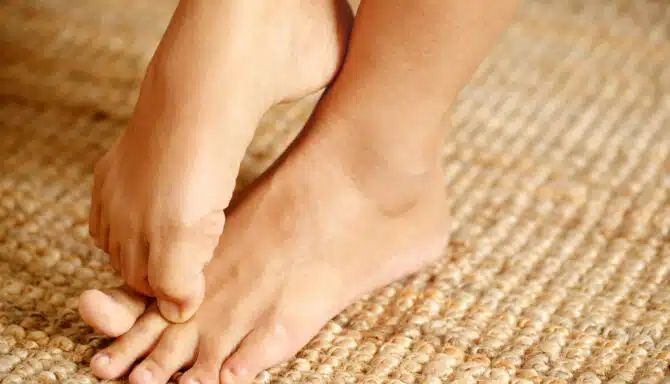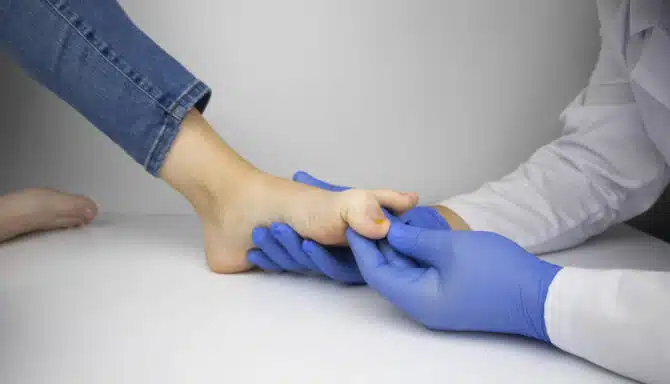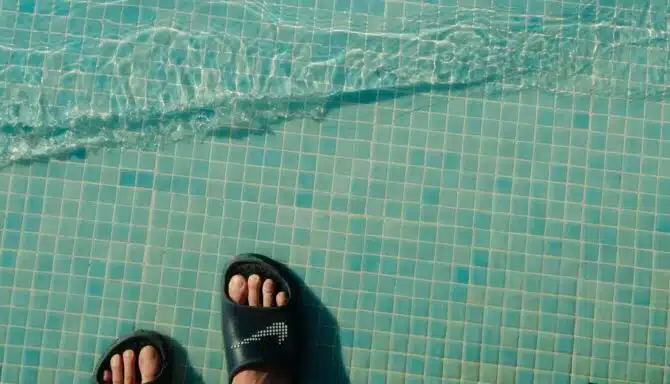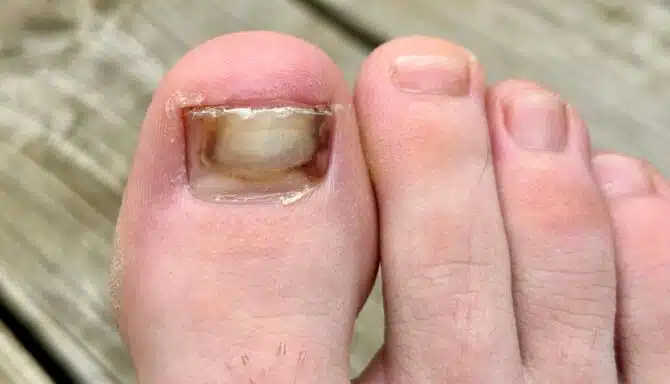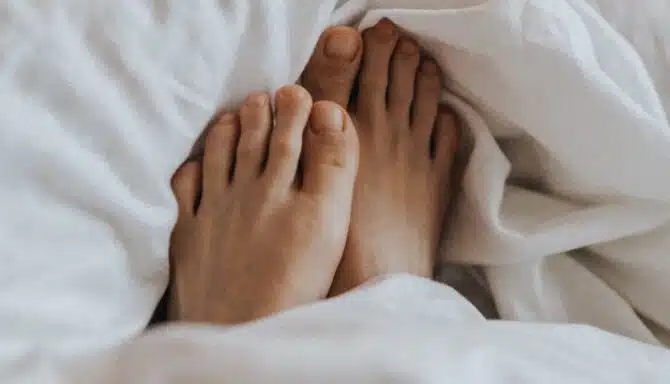April 3, 2025
Healthy toenails need healthy circulation, but when blood flow is compromised, they can become brittle, discoloured, or grow slowly. Additional toenail conditions can also develop. Poor circulation and toenail problems are closely linked, especially for those with health problems like diabetes or peripheral artery disease. Understanding why poor blood flow affects toenails can help you take the right steps to protect your foot health and prevent complications.
https://www.youtube.com/shorts/3JAUqiqJfus
The Importance of Blood Circulation
In order to understand the link between poor circulation and toenail issues, we have to start by understanding what blood flow is and what it does. The circulatory system, comprising the heart, blood vessels, and blood, serves as the body's transportation network. Its primary function is to deliver oxygen and essential nutrients to cells while removing waste products like carbon dioxide.
The heart pumps oxygen-rich blood through arteries, which branch into smaller arterioles and capillaries, reaching every tissue and organ. This process ensures that each cell receives the necessary components for energy production, growth, and repair.
Efficient blood circulation is vital for overall health. Oxygen transported by red blood cells is crucial for cellular respiration, the process by which cells generate energy. Nutrients absorbed from digested food are distributed via the bloodstream to support various bodily functions.
Key nutrients delivered by the bloodstream include:
Glucose: A simple sugar derived from carbohydrates in our diet, glucose serves as the primary energy source for cells, fueling various physiological processes.
Amino Acids: These are the building blocks of proteins, obtained from the digestion of dietary proteins. Amino acids are crucial for tissue growth, repair, and the synthesis of enzymes and hormones.
Fatty Acids and Lipids: Essential components of cell membranes and energy storage molecules, fatty acids and lipids are transported to cells for incorporation into cellular structures and for energy production.
Vitamins and Minerals: These micronutrients support a range of cellular functions, including maintaining bone health and facilitating nerve transmission.
Hormones: Although not nutrients in the traditional sense, hormones are vital signaling molecules transported by the circulatory system to regulate various physiological activities, such as metabolism, growth, and mood.
Impaired circulation can slow down healing processes—even for seemingly innocent and minor problems like cuts and scrapes. Likewise, organs and tissues deprived of adequate circulation can suffer damage over time, increasing the risk of conditions such as peripheral artery disease, stroke, and heart attacks.
Toenail Health and Circulation: The Connection
The circulatory system delivers oxygen and essential nutrients to the nail beds, supporting the growth and maintenance of strong, clear nails. When blood flow is compromised, the nails may not receive adequate nourishment, leading to various issues such as brittleness, discoloration, and slowed growth. In some cases, poor circulation can cause nails to develop ridges, indicating underlying vascular problems.
Reduced blood flow can also increase the risk of infections like toenail fungus (onychomycosis). A weakened circulatory system impairs the body's ability to combat pathogens, making the toenail environment more susceptible to fungal overgrowth. This often results in yellowed, thickened nails that you can’t treat without the help of a chiropodist or podiatrist. They must remove the infected portion of the nail so they can apply the correct medicine.
Poor blood flow on its own may not cause a problem with your foot health, but it can contribute to the following toenail conditions:
Slow or halted nail growth: Inadequate blood flow deprives the nail matrix of essential nutrients and oxygen, resulting in reduced or ceased toenail growth. This can be very frustrating if your toenail falls off or cracks and you’re waiting for it to grow back, leaving your feet vulnerable.
Brittle and discolored nails: Insufficient circulation can cause nails to become brittle and change color, often appearing yellowed or darkened.
Thickened nails: Poor blood flow may contribute to the thickening of toenails, often via toenail fungus, making them difficult to trim and maintain. Poor blood flow also affects the nail growth process, which can cause nail cells to pile on top of each other and lead to thicker toenails.
Ingrown toenails: While not directly caused by poor circulation, individuals with compromised blood flow, such as those with diabetes, are at higher risk for complications from ingrown toenails, including infections and delayed healing.
Diabetes, Toenail Health and Circulation
Diabetes can lead to two significant complications affecting foot health: diabetic neuropathy and peripheral artery disease (PAD). Diabetic neuropathy results from prolonged high blood sugar levels damaging the nerves, particularly in the legs and feet, causing numbness, tingling, or a loss of sensation.
This diminished sensitivity means that innocent injuries, such as cuts or blisters, may go unnoticed, increasing the risk of infections and complications like ulcers, or in severe cases, life threatening problems like gangrene, which require amputation. This is also the case for seemingly minor problems with the toenails. Simultaneously, PAD causes blood vessels to narrow and harden, reducing blood flow to the extremities. This impaired circulation hampers the delivery of oxygen and essential nutrients needed for healing, making the feet and toenails even more susceptible.
Regular foot inspections and nail care with a chiropodist or podiatrist, maintaining proper hygiene, and promptly addressing any abnormalities are crucial steps for diabetics to prevent toenail-related complications stemming from poor blood flow.
https://www.youtube.com/shorts/QFWBwM6mGqM?feature=share
Foot and Nail Care for Poor Circulation
Maintaining proper foot and nail care is essential for individuals experiencing poor circulation, as reduced blood flow can lead to various complications. Here are some recommended practices and treatments:
https://youtu.be/5PCZuM5E6RU
Regular Exercise: Maintaining good circulatory health through regular exercise, a balanced diet, and avoiding smoking is essential for ensuring that the body's systems function as well as possible. One of the best circulation maintenance tips for foot health is working the muscles in the lower extremities. Exercises like toe splays, toe flexes and raises, massage ball rolls, pen pick-ups and seated toe pulls can work wonders. Click here to learn the five best foot exercises to improve blood circulation. They’re particularly helpful in the winter, but are useful all year round.
Regular Self Inspections: Conduct daily checks for cuts, sores, or changes in nail color and texture to detect issues early.
Moisturizing: Keep feet hydrated to prevent cracks and fissures that can lead to infections. Learn how to moisturize properly here.
OnyFix Nail Correction System: For those with ingrown or involuted toenails, the OnyFix system offers a non-invasive, pain-free solution. This innovative treatment involves applying a composite material to the nail, which helps guide it back to its natural shape as it grows, without the need for surgery. It's suitable for various nail shapes.
Medical Pedicures: Unlike traditional cosmetic pedicures, medical pedicures are performed by trained foot care professionals, such as chiropodists or podiatrists, in a sterile environment in a foot clinic. They focus on health, addressing issues like nail trimming, callus reduction, and infection prevention. They are especially helpful for dealing with irregular shaped toenails caused by poor circulation - cutting and maintaining these on your own can be very difficult. For people with diabetes, who are at higher risk for foot complications due to poor circulation and neuropathy, medical pedicures are a common and recommended treatment. These specialized pedicures help prevent complications like infections or ulcers by ensuring meticulous foot care.
Proper Footwear: Wear well-fitting shoes that provide adequate support and reduce pressure points to promote better circulation.
Proper Nail Trimming: Trim nails straight across and avoid cutting them too short to prevent ingrown toenails. And if your toenails are too thick or difficult to cut on your own, book an appointment with a foot specialist.
March 20, 2025
Ram’s horn toenails? Sounds like a serious foot issue! And it is—this condition, medically known as onychogryphosis, causes thickened, curved nails that can become painful and difficult to manage over time. It doesn’t just affect nail appearance; it can lead to discomfort, infection, and mobility issues if left untreated. Fortunately, onychogryphosis treatment options from a chiropodist or podiatrist are available to help you manage comfort and nail health.
What Are Ram’s Horn Toenails?
View this post on Instagram A post shared by Feet First Clinic (@feetfirstclinic_)
Ram’s horn toenails (onychogryphosis), one of the many types of toenail conditions, is classified as a nail disorder or nail disease where the toenail becomes extremely thick, abnormally curved, and overgrown, often resembling the spiraled shape of a ram’s horn. This happens because the nail plate—made of keratin—grows unevenly due to disruptions in the nail matrix, the part of the nail bed responsible for new cell production. Instead of growing outward smoothly, the nail thickens, hardens, and may curl or twist due to uneven pressure and irregular cell turnover. They have a similar appearance to a severe fungal toenail infection.
The texture of a ram’s horn toenail is usually rough, ridged, and extremely hard, making it difficult to trim with standard nail clippers. Over time, the nail can develop a yellowish, brownish, or even grayish hue due to keratin buildup and potential fungal infections. In severe cases, the nail may grow so long and misshapen that it presses into the surrounding skin, causing pain, tenderness, and difficulty wearing shoes or walking comfortably. Because the thickened nail loses its normal flexibility, it can crack or split, increasing the risk of infection.
The appearance of onychogryphosis can also affect confidence and make it difficult to find shoes that accommodate their size and abnormal shape.
Although onychogryphosis most commonly affects the big toe, it can develop on others as well. It tends to progress gradually, meaning that early signs—such as mild thickening or slight discoloration—can go unnoticed until the nail has significantly changed in shape and texture.
Causes of Ram’s Horn Toenails
https://www.youtube.com/shorts/3JAUqiqJfus
These toenails do not generally form spontaneously without an underlying cause or risk factor. Let’s take a look at what generally causes this nail disorder.
Risk Factors for Ram’s Horn Toenails:
Trauma and Ill-Fitting Footwear
Repeated or acute trauma to the toenail can disrupt normal nail growth, leading to thickening and deformation. Continuous pressure and friction, such as from ill-fitting footwear, can cause microtrauma to the nail bed, contributing to the development of onychogryphosis. Essentially, the toenail thickens and starts growing in a different direction to protect itself.
Age
In general, our feet become more vulnerable with age due to several physiological changes that can occur, which can predispose us to onychogryphosis. For instance, reduced peripheral circulation, common in older adults, impairs blood flow to the extremities, leading to diminished oxygen and nutrient delivery to the nails. This alters the nail's natural growth process, causing nails to grow slower and nail cells to pile up on top of each other (rather than growing out). As a result, they thicken and can change shape. Additionally, decreased mobility in the elderly may lead to inadequate foot care, contributing to nail abnormalities.
https://www.youtube.com/shorts/gEi59gq5g54
Diabetes
Diabetes significantly increases the risk of developing onychogryphosis, particularly due to the effects of diabetic neuropathy. Diabetic peripheral neuropathy reduces sensation in the feet, so individuals may not notice pressure, injuries, or trauma to the toenails, which can lead to deformities like onychogryphosis. Without the ability to feel discomfort, they may unintentionally cause damage to the nail, leading to thickening, curling, and other changes associated with the condition. Additionally, poor circulation caused by diabetes can impede healthy nail growth, making the nails more prone to abnormalities.
Peripheral Vascular Disease (PVD)
As already discussed, poor circulation affects the nail growth process and can lead to nail deformities. In particular, peripheral vascular disease involves the narrowing of peripheral arteries, reducing blood flow to the limbs. The diminished circulation can cause various symptoms, including slow or unusual nail growth. Without proper blood flow, the nails may become thickened and misshapen, potentially progressing to onychogryphosis if left untreated.
Cognitive Impairment
Relating back to age as a risk factor, conditions such as dementia can lead to neglected foot care due to cognitive decline. Individuals with dementia may forget or be unable to perform regular foot hygiene practices, increasing the risk of nail deformities like onychogryphosis. Self neglect, or infrequent cutting of toenails for a significant amount for any reason, is also a risk factor.
High-Friction Sports and Activity
Participating in high-friction sports like running, soccer, or ballet can increase the risk of developing onychogryphosis. Repetitive pressure and friction from constant movement or improper footwear during these activities can cause trauma to the toenail, leading to thickening, curling, and potential deformity. Runners, for example, often experience repeated impact on their toenails, particularly the big toe, which can cause them to become damaged or misshapen over time. Additionally, athletes who wear shoes that are too tight or too loose, which cause friction and rubbing, are more likely to develop toenail issues. As is the case with ill-fitting footwear, over time, the nail thickens and changes growth direction in order to protect itself from the repetitive trauma.
Hyperuricemia
High levels of uric acid in the blood is often associated with gout, but it can also contribute to the development of onychogryphosis. Elevated uric acid can lead to the deposition of urate crystals in joints and tissues, including the nails, which can cause inflammation and damage. This buildup may result in nail thickening, distortion, and a rough appearance. While gout primarily affects joints, the condition’s systemic nature can also have an impact on nail health
Fungal Infections
Also known as onychomycosis, fungal infections cause thickening and nail distortion. These infections often thrive in warm, moist environments and can infiltrate the nail, leading to changes in color, texture, and shape. In diabetic patients, onychomycosis prevalence is notably higher, reaching up to 31.5%, due to factors like elevated blood glucose levels and compromised immune response.
Psoriasis / Psoriatic Arthritis
Psoriasis or psoriatic arthritis can cause nail changes in roughly half of affected individuals. Proper management of psoriasis through medical treatments can help alleviate these nail changes and improve overall nail health.
Treating Ram’s Horn Toenails: Nail Care for Curved Toenails
https://www.youtube.com/shorts/QFWBwM6mGqM
Routine Professional Nail Care
It’s very important to visit a Podiatrist or Chiropodist, both types of foot specialists in Ontario, if you have Ram’s horn toenails. This is because it is far too difficult, even dangerous, to manage them yourself. Their thickness, abnormal shape and unsightly appearance and positioning on your foot make it impractical to try cutting them with standard nail clippers, and is not advised.
A chiropodist or podiatrist can tend to your nails properly with specialized tools designed to maintain nail disorders. They can also perform toenail debridement, smooth out nail edges, clean out debris, and apply sprays that help with discoloration.
Other nail care treatment options may vary depending on the severity of the condition. In more extreme cases, surgical interventions such as nail avulsion—removal of the nail plate—may be considered.
If an infection is present, a chiropodist or podiatrist can prescribe the appropriate antifungal or antibacterial treatments to address the underlying cause (you can't treat fungal infections from home).
In addition to the specialized care provided by podiatrists and chiropodists, treatment for Ram’s horn toenails can also include regular monitoring to track any changes in the condition. They may suggest specific at-home care practices, such as gentle cleaning and moisturizing, to support the overall health of the nails and surrounding skin. For individuals with chronic conditions, like diabetes, it is especially important to maintain close contact with a foot care specialist to ensure the toenails remain manageable and complications are avoided. Diabetes patients who neglect their foot health can experience severe ulcer formation.
Onyfix
Onyfix is just one of the many unique ways a foot specialist can help treat curved, curled or Ram's Horn Toenails. It's a non-surgical treatment that involves the placement of a band across the toenail. This band then corrects the nail's growth pattern and shape. It's great for Ram's Horn Toenails because it will help flatten out the toenail on the nail bed and "train" the toenail to grow in the correct direction.
Proper Fitting Footwear
But all the treatment in the world won't matter without eliminating one of the most common causes of curved, curled and abnormal toenails: ill-fitting footwear. As we already discussed, ill-fitting footwear causes repetitive trauma on the nailbed, which disrupts the toenail's growth process. Prioritizing footwear that minimizes pressure and allows for adequate toe room to alleviate discomfort and prevent further nail distortion is key. Opting for shoes with a wide toe box provides ample space for the toes to spread naturally, reducing friction and pressure on the affected nails. Shoes may also require extra depth, and orthopedic footwear may be required for sufficient comfort.
Featured Photo By PixaBay
January 30, 2025
Toenail conditions can cover a wide range of problems, each with its own set of symptoms. Typical causes and risk factors include wearing ill-fitting shoes over long periods, contracting contagious fungi, infections, cutting your toenails incorrectly, having poor circulation and more. Today we’ll talk about the 5 most common toenail conditions and what you can do to address each one. Nailed it!
5 Common Toenail Conditions
Ingrown toenails
Toenail fungus
Cracked/stubbed toenails
Discoloured toenails
Onycholysis
Risk Factors for Common Toenail Problems
Improper nail trimming, such as cutting nails too short or rounding edges.
Wearing tight or ill-fitting footwear that puts pressure on the toes.
Frequent exposure to damp or moist environments - this leads to fungal infections, which can spread and worsen without treatment.
Walking barefoot in communal areas, which increases exposure to fungi and bacteria.
Trauma to the toes, such as stubbing or dropping heavy objects.
Poor foot hygiene, leading to debris buildup and a more favourable environment for bacteria and fungi.
Genetics, including naturally curved nails or a family history of nail issues.
Poor circulation, which disrupts the natural toenail growth process and can lead to an array of toenail deformities and misshapen toenails.
Medical conditions like diabetes or peripheral vascular disease, which impair circulation and healing. It's extremely important to attend regular appointments with a chiropodist or podiatrist if you have diabetes as even deceptively minor issues, like cracked toenails or ingrown toenails, can turn into diabetic ulcers when ignored.
Psoriasis or other skin conditions affecting the nails.
Weak or brittle nails caused by aging, poor nutrition, or overuse of harsh chemicals (too many cosmetic pedicures).
Repetitive pressure on nails from activities like running or wearing high heels.
1. Ingrown Toenails
https://www.youtube.com/shorts/LoCcoKOhV7E
Ingrown toenails are one of the most common toenail problems, with some studies suggesting they affect 20% of patients who seek medical care for foot-related issues. They occur when the edges or corners of a toenail grow into the soft skin surrounding it. This leads to inflammation, swelling, and pain. The big toes are particularly prone to this condition due to their size and the pressure they endure during daily activities.
Nails grow from the nail matrix, a layer of tissue beneath the cuticle that produces keratin, the protein that forms the nail. Healthy nails grow straight outward, following the curve of the toe. However, if the nail is cut incorrectly, exposed to excessive pressure and toe crowding in shoes, or grows irregularly due to genetics, its edges can deviate and pierce the surrounding skin.
Once the nail edge enters the skin, the body identifies it as a foreign object. This triggers an inflammatory response, where blood flow to the area increases, causing redness, swelling, and pain. If bacteria enter the wound, infection may develop, leading to pus and further discomfort.
Treatment for ingrown toenails depends on the severity of the condition and the individual’s needs. For mild cases, conservative care such as warm water soaks, antibiotic ointments, and proper nail trimming can help alleviate discomfort and prevent infection. Professional treatments offer more targeted solutions.
OnyFix is a non-invasive option that uses a specialized band applied to the nail, gently guiding its growth to prevent future ingrown edges without the need for surgery. Medical pedicures, performed by a chiropodist or podiatrist, safely address ingrown nails by trimming and reshaping them with sterilized tools while maintaining overall nail health. For severe or recurrent cases, surgical interventions such as partial or total nail avulsion may be necessary to remove the problematic portion of the nail and ensure long-term relief. Consulting a foot care specialist is key to determining the most effective treatment plan.
https://www.youtube.com/shorts/ZsFQqCkVf40
2. Toenail Fungus
Fungal toenails occur when fungi infect the nail bed, causing changes in the nail's colour, texture, and thickness. The fungi thrive in warm, moist environments, which makes the toes a prime target, especially in people who wear tight shoes, sweat excessively, or walk barefoot in public areas. Over time, the nail may become discoloured (yellow, brown, or white), thickened, and brittle, and it may even begin to separate from the nail bed.
Fungal infections can be persistent and difficult to treat due to the fact they’re essentially stuck under the nail. This means professional intervention from a chiropodist or podiatrist is necessary.
https://www.youtube.com/shorts/jo9Ro-iGU2s
3. Cracked / Stubbed Toenails
Cracked and stubbed toenails often coexist. They occur when the nail becomes brittle and breaks, often due to factors like dehydration, excessive moisture, or external pressure from tight shoes. The nail’s keratin structure weakens, leading to splits or fractures. Stubbed toenails, on the other hand, happen when the toe is forcefully struck, causing immediate pain and potential damage to the nail, which includes cracking.
You can usually let your cracked toenails grow out naturally. If the nail is cracked due to sudden trauma and there is no other culprit at play, this will take about 6 to 8 weeks to start, and sometimes over a year to completely regrow properly. A chiropodist or podiatrist might be able to provide a remedy to encourage faster growth, and suggest the best footwear for your feet to avoid toe crowding and further nail damage.
In the case of complications or a more sinister underlying problem, a foot specialist may partially or fully remove the nail (avulsion) or apply dressing to the area to prevent infection.
https://www.youtube.com/shorts/lArn5KLnnSA
4. Discoloured Toenails
Discoloured toenails are more of a symptom than a problem. When the nail changes colour, it often reflects a problem with the nail, tissue beneath it, or your general health. Fungal infections, for example, commonly cause yellow or brown discoloration, as the fungi damage the nail and its growth. Trauma can also lead to discolouration, often presenting as a dark bruise (purple or black) due to blood pooling under the nail.
Nail Discolouration Causes and Colours:
Yellow: Fungal infections, thickening, aging.
Black: Trauma or bruising beneath the nail, potentially accompanied by blood pooling.
White spots: Trauma, fungus, allergies — generally harmless.
Bluish/Pale: Circulation issues, anemia, or other health conditions.
Treatment is difficult to discern as many factors may be causing discolouration. The best course of action is scheduling a foot assessment or nail care appointment with a chiropodist or podiatrist at a foot clinic.
5. Onycholysis
This is a term for when your nail starts to separate from the nail bed. It often coexists with toenail fungus, psoriasis or trauma/toe injuries. Depending on the cause, you may need a full course of fungal toenail treatment at a foot clinic. A Chiropodist or Podiatrist will determine what’s causing the problem and curate a specialized treatment plan. As mentioned before, the detached portion of your nail will usually grow back on its own if it's separated because of trauma.
https://www.youtube.com/shorts/QFWBwM6mGqM
Prevention Tips for Common Toenail Problems
Trim nails straight across and avoid cutting them too short.
Wear properly fitting footwear that allows adequate toe room.
Maintain good foot hygiene, including regular washing and drying of feet.
Avoid walking barefoot in communal areas to reduce the risk of fungal infections.
Keep feet dry, especially in winter, and use moisture-wicking socks to prevent fungal growth.
Protect toes from trauma by wearing protective footwear in hazardous environments.
Moisturize nails and cuticles regularly to prevent brittleness and cracking.
Avoid harsh chemicals, including acetone-based nail polish removers.
Monitor nails for discoloration, thickening, or unusual texture changes.
Seek professional care from a Chiropodist or Podiatrist if you suspect you have a fungal infection.
Seek professional care from a Chiropodist or Podiatrist if you notice persistent pain, redness, or swelling.
Schedule foot assessments and regular medical pedicures with a Chiropodist or Podiatrist so they can keep an eye on your feet — four eyes are better than two!
September 5, 2024
Athlete's foot is a fungus that infects the skin on your feet. Many people get it, and it can cause a lot of problems. Your feet may itch, turn red, and peel when you have it. This fungus grows best in places that are warm and damp. The good news is that you can treat and stop athlete's foot if you know what to do. Here are some tips from chiropodists (foot specialists) to help you keep your feet healthy and free from fungus.
Treatment strategies
See a Chiropodist
Because of all the moisture buildup on our feet, fungal infections can grow out of control very quickly; they're stubborn and persistent, and once the infection gets under the toenail, it becomes very difficult to treat. In addition, over-the-counter anti-fungal medications are not very effective unless the infection is in the very early stages. That's why it's important to see a chiropodist as soon as you notice any symptoms. A chiropodist will debride and clean up any fungal growth on the skin and prescribe a topical anti-fungal medication to help nip the athlete's foot in the bud before it spreads to the toenails. Oral anti-fungal medications, while effective, are often not recommended due to their side effects. Often, topical prescription anti-fungal medication and persistence are the best way to go.
Maintain a rigid hygiene routine
Your feet and body will thank you if you keep the infected area clean and dry. Wash your feet daily with soap and water and dry them well between your toes. Fungus grows best in damp places, so ensure your feet are dry before putting on socks and shoes. If you're particularly prone to sweaty feet, you can also try an anti-bacterial foot deodorant like Gehwol's Foot Deodorant spray. This can help prevent Athlete's foot, and even treat it in its very early stages.
Avoid scratching
Scratching the infected spot can cause other bacterial infections. To soothe the itch, try using antifungal creams or powders. If the infection gets worse or spreads, talk to a doctor.
Change socks regularly
Choose cotton or merino wool socks that let your feet breathe and wick away sweat. Wear fresh socks every day and change them after physical activity or when they get wet. This helps reduce moisture build-up, which can worsen the fungal infection.
Prevention Tips
Avoid walking barefoot in public
Athlete's foot, along with other fungal infections, are contagious and spread when skin comes into contact with an infected surface. Therefore, always make sure you are wearing some kind of protective footwear in public spaces - like flip flops or slippers - in locker rooms, communal showers, pool decks and gymnasiums.
Stick to a foot care routine
Clean your feet and dry them well between your toes. Also make sure you cut and clean your toenails often, as fungi can hide under the toenails. Just make sure you don't cut them too short, or you can get an ingrown toenail.
Put on the right shoes
Pick shoes that let air flow through them. Avoid (if possible) wearing the same shoes all day, every day, and ensure they're dry before putting them on. Use flip-flops or water-safe sandals in public spots like pools or gym showers to avoid touching infected surfaces.
Clean Your Shoes
Fungal spores can hang around in shoes, which will feed the infection. To combat this, spray your shoes and socks with antifungal and antibacterial products, such as hypochlorous acid, zinc oxide or zinc incoleate, and dry them out before you put them on again.
You can use Gehwol Foot & Shoe Deodorant Spray in your shoes, or dust Gehwol Foot Powder into your socks. These products contain zinc oxide and zinc ricinoleate, respectively, which are great for maintaining a healthy environment in your shoes. You can find these products at our Toronto foot clinic.
Keep personal items to yourself
Don't let others use your towels, socks, or shoes, and vice versa. Fungal infections are contagious and spread through touching or sharing personal items with people who have a fungal infection.
August 1, 2024
A toenail falling off can be uncomfortable and cause concern about damage to the toenail. The goal is to preserve the toenail's state to prevent further damage.
Fortunately, if you take a few proactive steps, you can reduce the discomfort and promote healing. Here are our six tips for managing a toenail on the verge of falling off.
1. Keep the toenail area clean and dry
Wash the toenail gently and often. We recommend using mild soap and water to keep it clean. Next, pat dry so as not to snag the toenail with a towel.
2. Cut the nail carefully and slowly
Use clean, sterilized nail clippers to remove any dangling or loose portions of the toenail. Cut straight across without digging into the surrounding skin. The goal here is to prevent further snagging or tearing down the road. Improperly cutting your nail may also increase your risk of an ingrown toenail.
In addition to trimming the toenail straight across, you should trim the toenail slowly. Don't over-cut it. Be patient with toenail growth. (It may take months to a year for a nail to fully grow out.) If in doubt, let our toenail specialists in Toronto trim your toenails for you as part of a medical pedicure.
3. Use a non-stick bandage to protect the area
We recommend applying a bandage or non-sticky wrap to your toe. (Adhesive can attach itself to the toenail and be difficult to peel off without grabbing onto it.) A protective layer keeps an otherwise exposed nail bed safe. Replace the bandage regularly and keep the area dry to promote healing.
4. Antiseptic ointment is your friend
Use an antiseptic ointment or petroleum jelly on the exposed nail bed to keep it moisturized and prevent infection. This may help soothe any discomfort from the loose toenail.
5. Choose comfortable and roomier footwear
You'll want to reduce pressure as much as possible to prevent a loose toenail from falling off. Given that we wear footwear so often, finding shoes with ample fit can help prevent further damage to the toenails.
6. Avoid intense activity
Reduce your activity level if it puts excessive pressure or strain on the affected toenail. For instance, running or high-impact sports like soccer could increase the risk of the toenail getting snagged or torn off. Give your toe some rest, and return to physical activity gradually.
June 20, 2024
At first glance, our toenails look like a single nail, and that's about it. However, beneath the surface is a more complex structure that makes up the nail and the bed below it. This is our toenail anatomy.
Toenails and fingernails are made of Keratin. Keratin is a type of protein that gives the nail strength and protection. (There are many types of Keratin. It also comprises hair and your epidermis.) Toenails differ from fingernails in a few ways, namely their thickness and growth rate, as the external forces on your toenails are greater than those on your hands.
Today, we explore toenail anatomy and how each component affects foot health.
Layers of the toenail
Nail plate
The nail plate is the easiest part of the toenail anatomy to recognize. It's the nail itself. The colour and texture of the nail plate can vary based on factors like health, genetics, and lifestyle habits.
Nail bed
Next, we go a bit deeper. The nail bed is beneath the nail plate. Just like sheets and blankets are the nail plate, imagine the nail bed is the mattress or bed frame below. The nail bed is a layer of skin that nourishes the nail as it contains blood vessels and nerves. It is also the growth engine behind the nail plate.
If you damage the nail bed, you'll notice nail plate abnormalities or reduced growth rates. Sometimes, a damaged nail bed will cause you to lose a toenail or experience a discoloured toenail. A subungual hematoma occurs within the nail bed and can cause a black toenail.
Lunula
The lunula, or "half-moon," is the pale, crescent-shaped area visible at the base of the nail. It represents the edge of the nail matrix, where new nail cells are generated. Eventually, nail growth from the lunula extends out to the outer edges of the nail, at which point you'd trim them.
Nail matrix
The nail matrix is the tissue beneath the cuticle at the base of the nail. It produces new nail cells, pushing older cells forward and resulting in nail growth. Damage to the nail matrix can affect the quality and growth rate of the toenail. Each nail matrix produces 196 layers of cells that combine to make your toenails.
